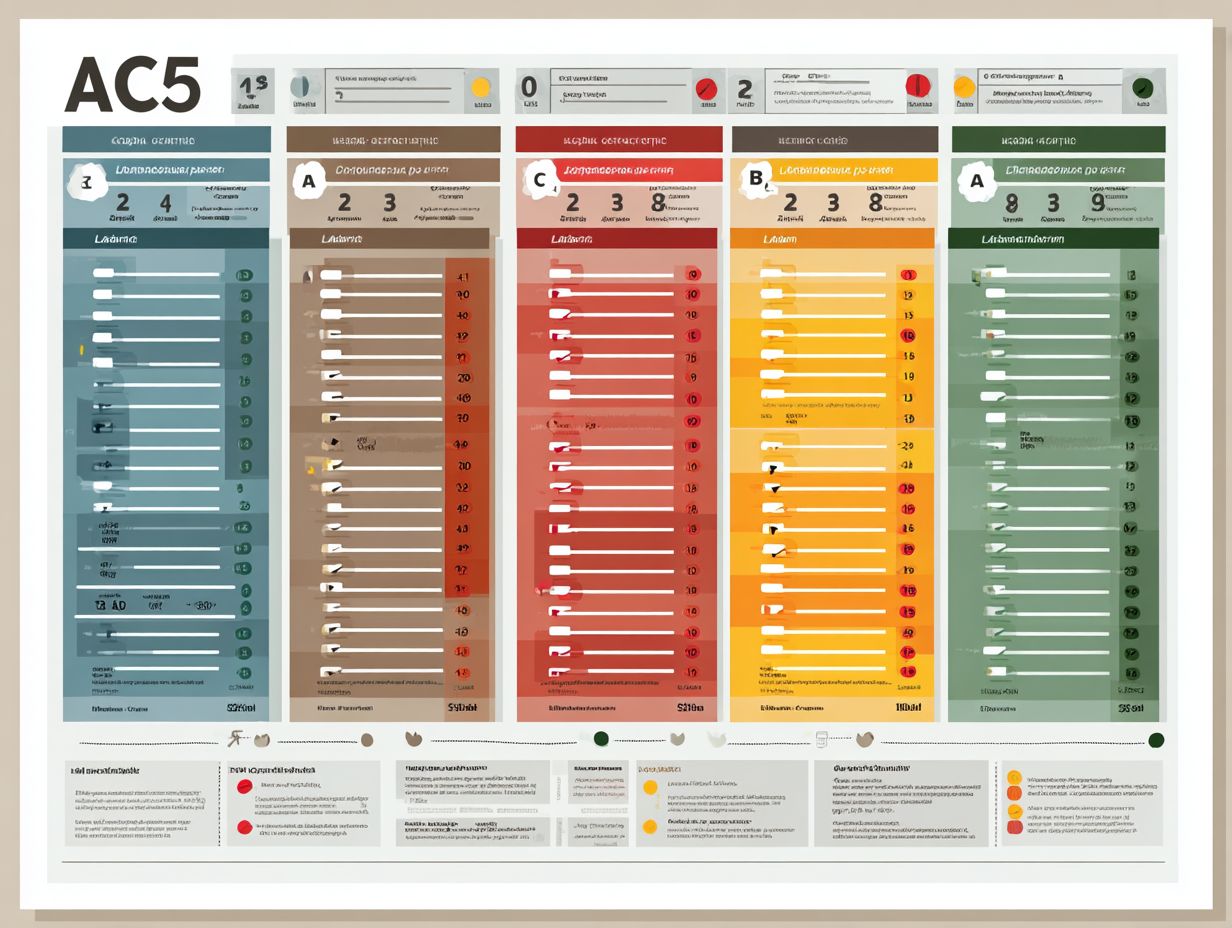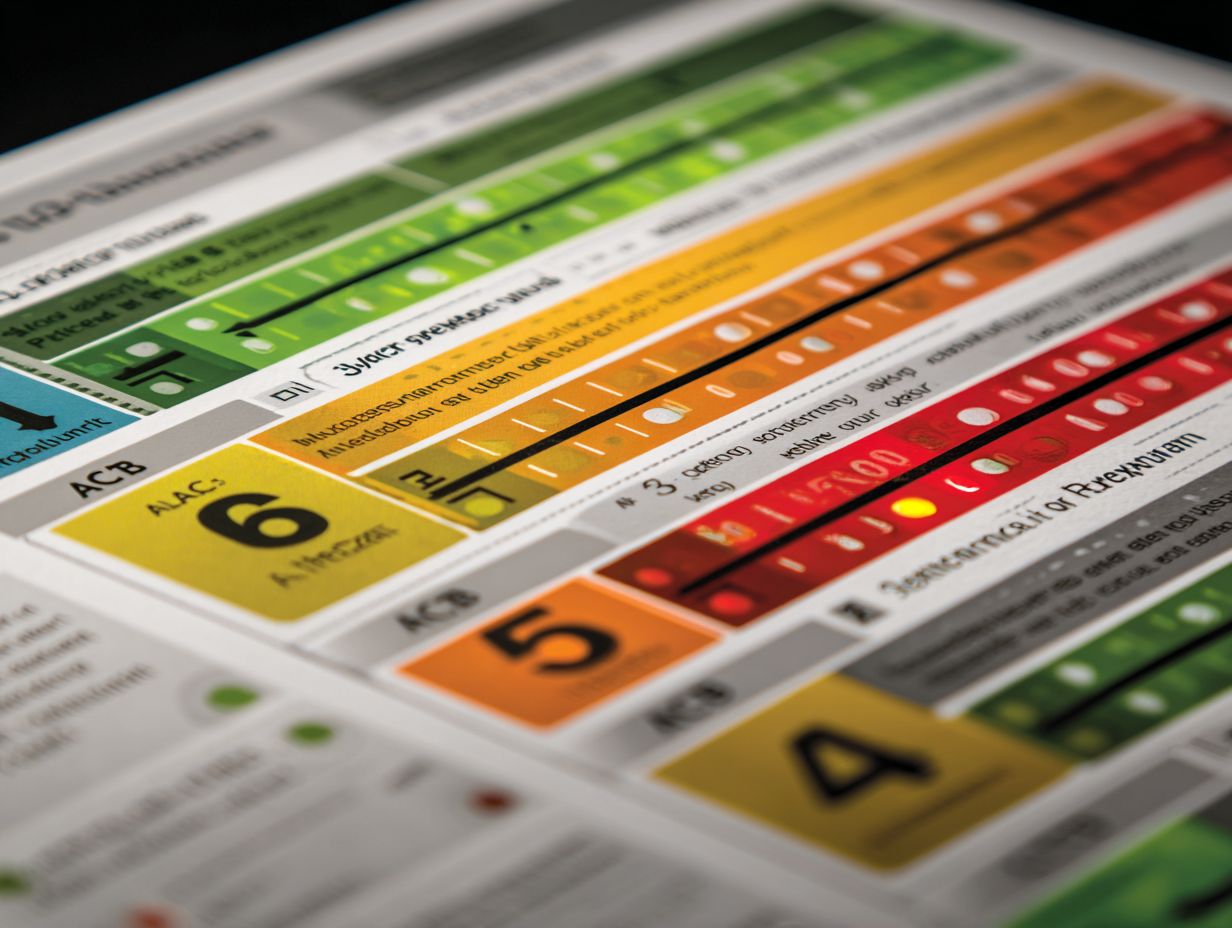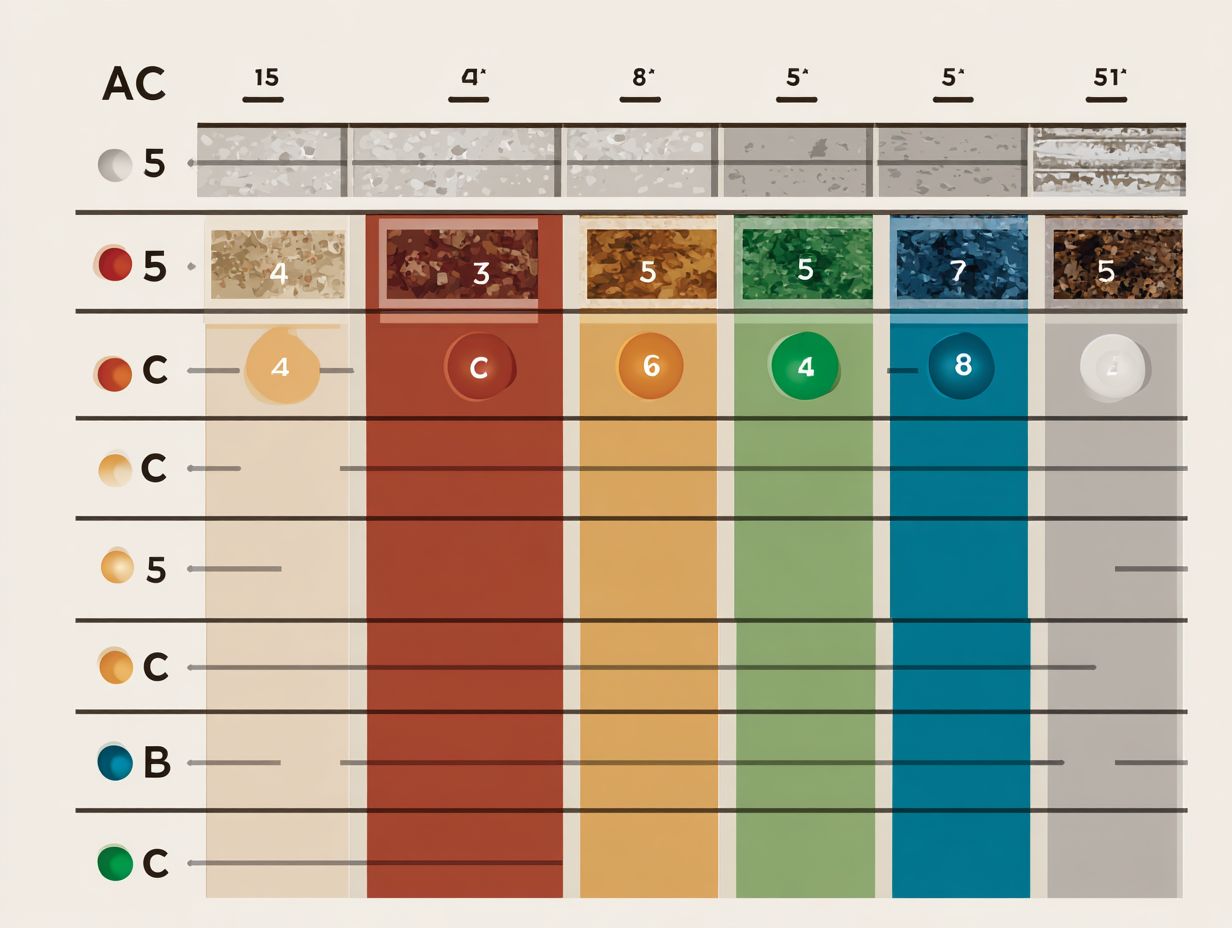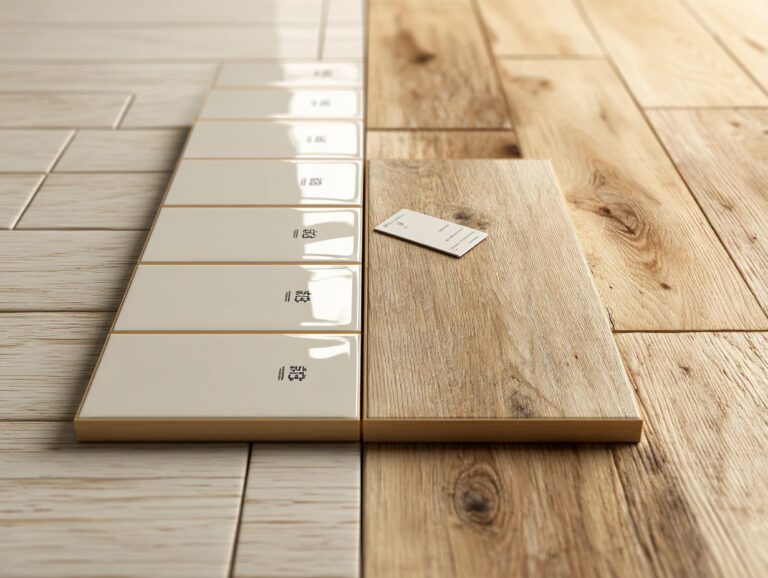Laminate AC Ratings Explained – AC1 through AC5 Guide
When choosing laminate flooring, knowing AC ratings is important. These ratings, which range from AC1 to AC5, directly reflect the durability levels of laminate products, helping you choose the right option for both residential areas and commercial spaces. In this Flooring 101 guide, we’ll break down each laminate AC rating, ensuring you make an informed decision that’ll stand the test of time. Find the best option for you!
Key Takeaways:
Contents
- Laminate Flooring Durability Statistics
- Understanding the AC Rating System
- AC1 Rating: General Use
- AC2 Rating: Moderate Residential Use
- AC3 Rating: Heavy Residential and Light Commercial Use
- AC4 Rating: Commercial Use
- AC5 Rating: Heavy Commercial Use
- Comparing AC Ratings
- Frequently Asked Questions
- What do the AC ratings mean for laminate flooring?
- What is the difference between AC1 and AC5 ratings?
- What does AC stand for in laminate flooring?
- Can I use an AC3 rated laminate flooring in a commercial space?
- Is it necessary to choose a higher AC rating for my laminate flooring?
- Are there any other factors to consider when choosing a laminate flooring with a specific AC rating?
What are Laminate AC Ratings?

Laminate AC ratings classify the durability and wear resistance of laminate flooring, ranging from AC1 to AC5 based on their performance in specific environments.
AC1 works well for bedrooms with light use, while AC2 is better for living rooms and dining areas with medium traffic.
AC3 is designed for higher residential and light commercial use, such as offices. For homes with a lot of activity or businesses with moderate use, AC4 is recommended for its strong durability. AC5 is made for busy commercial spaces, handling heavy use well. For more detailed insights into laminate flooring, including its construction and benefits, you can explore our comprehensive guide on Understanding Laminate Flooring – Construction & Benefits.
Each rating reflects standardized tests, including abrasion resistance and impact testing, ensuring reliability across various applications.
Importance of AC Ratings in Laminate Flooring
AC ratings serve as a critical guide for consumers, ensuring that the selected laminate flooring meets both aesthetic and functional needs in varied spaces.
Choosing the right AC rating directly influences the flooring’s durability and suitability for different environments. For instance, an AC3 rating is suitable for light commercial use and can withstand occasional spills, while AC5 is ideal for heavy traffic areas like offices.
According to a recent survey, 78% of homeowners prefer AC4 rated laminate for its balance of durability and affordability. Knowing these ratings helps customers choose a product that improves their space and lasts a long time.
Laminate Flooring Durability Statistics
Laminate Flooring Durability Statistics
Laminate Flooring Market Analysis: Sales Decline
Laminate Flooring Market Analysis: Square Footage Decline
Laminate Flooring Market Analysis: Laminate Import Changes
Laminate Flooring Market Analysis: Sales by Channel
The Laminate Flooring Durability Statistics offers a detailed review of the laminate flooring market’s present condition and developments. This dataset provides information on sales results, market share, import trends, and distribution methods, assisting stakeholders in grasping the market’s direction.
Sales Decline data reveals a reduction in sales decrease from 9.8% in 2023 to 7.5% in 2024. This improvement, although still negative, suggests a stabilization in the market, potentially driven by renewed interest or better economic conditions.
Square Footage Decline indicates a downward trend in volume, with a reduction from a 11.7% decrease in 2023 to a 4.8% decline in 2024. This may reflect changes in consumer preferences, where other flooring options like luxury vinyl tiles are gaining popularity due to their durability and aesthetic appeal.
In terms of Market Share, laminate flooring’s share in total flooring sales slightly decreased from 5.0% in 2023 to 4.8% in 2024. This minor shift indicates a competitive market where laminate flooring maintains a stable yet modest presence compared to other materials.
The data on Laminate Import Changes is notable, with Chinese imports decreasing from 26.0% in 2023 to 19.0% in 2024. This significant reduction could be due to trade policies, tariffs, or a shift towards domestic production, affecting the supply chain and pricing strategies.
Sales by Channel highlights distribution dynamics, where specialty retail stores account for 30.0% of sales, focusing on their role in offering personalized customer interactions and details. Home centers like Home Depot and Lowes hold 27.0% and 16.0% shares respectively, showcasing their role in reaching a broad customer base with competitive pricing and extensive product ranges. Meanwhile, warehouse clubs only capture 5.0%, suggesting limited impact but potential for growth in bulk selling or cost-effective options.
Overall, the Laminate Flooring Market Analysis illustrates a market facing challenges but showing signs of stabilization. The drop in Chinese imports and changing ways goods are sold show chances for local growth and aligning plans with what consumers want.
Understanding the AC Rating System
The AC rating system is a set method created by the European Producers of Laminate Flooring (EPLF) to measure how long laminate lasts and if it is right for various settings.
Overview of the AC Rating Scale

The AC rating scale ranges from AC1, suitable for light residential use, to AC5, which is designed for heavy commercial environments, reflecting escalating levels of durability.
Each level has specific applications:
- AC1 is ideal for small spaces like home offices,
- AC2 accommodates moderate use in apartments.
- AC3 supports standard commercial environments such as shops.
In industries such as manufacturing, AC4 offers strong resistance to wear, while AC5 is suitable for areas with heavy use, like warehouses.
When choosing a rating, consider factors such as foot traffic, intended use, and maintenance. Tools like durability measurement guides can help determine the right AC rating for your specific needs.
How AC Ratings are Determined
AC ratings are established by thorough testing, which includes evaluating how well the material withstands wear and how it holds up against impacts in controlled settings.
One key method is the Taber test, where samples are subjected to abrasive wheels to assess surface wear. Facilities like the National Institute of Standards and Technology (NIST) perform these tests, simulating years of wear in just a few days.
Typical results show that higher AC ratings correlate with greater resistance; for instance, a laminate with an AC3 rating might only show slight wear after thousands of cycles, while an AC5 laminate can withstand significantly more abuse.
This careful assessment guarantees dependable flooring performance in homes and businesses.
AC1 Rating: General Use
AC1-rated laminate is mainly used in homes with little foot traffic, providing simple strength and cost-effectiveness for homeowners.
Characteristics of AC1 Laminate
AC1 laminate has a wear layer thickness of 0.08 mm, which makes it ideal for places with little foot traffic and lightweight furniture.
This type of laminate features a core made from high-density fiberboard (HDF), ensuring durability despite its light use. Options for aesthetics are abundant, including various wood grains and colors that can mimic natural materials.
For comparison, AC2 laminate typically has a 0.12 mm wear layer for moderate traffic, while AC3 offers 0.20 mm for heavy-duty areas. Choosing between these grades hinges on evaluating your space’s expected usage, with AC1 being ideal for bedrooms or studies.
Best Applications for AC1
Ideal applications for AC1 laminate include bedrooms, guest rooms, and home offices, where foot traffic is limited and durability demands are lower.
For these areas, AC1 laminate offers an affordable flooring solution that mimics the look of hardwood while providing easy maintenance. It’s particularly well-suited for low-traffic zones such as nurseries or reading nooks, where aesthetic appeal is desired without the heavy wear and tear.
Avoid using AC1 laminate in high-traffic areas like living rooms or hallways, as it may wear quickly and is susceptible to scratches and dents. For those areas, think about using AC2 or AC3 laminates for better strength.
AC2 Rating: Moderate Residential Use
Designed for regular home use, AC2 laminate is stronger, making it suitable for areas with a bit more foot traffic than those using AC1.
Characteristics of AC2 Laminate
AC2 laminate usually has a wear layer that is 0.15 mm thick, offering better protection against regular household use.
This thickness offers a better defense against scratches and stains than AC1, which typically has a wear layer around 0.08 mm.
The core material of AC2 laminate often includes high-density fiberboard (HDF), enhancing its durability and moisture resistance. This makes it suitable for moderate foot traffic areas like living rooms and dining spaces.
In comparison, AC1 is more suitable for low-traffic areas such as bedrooms or home offices, where wear and tear is minimal.
Considering these factors will help you choose the right laminate for your space.
Best Applications for AC2
AC2 laminate is best suited for living rooms, dining areas, and home offices where moderate foot traffic is expected, ensuring longevity and aesthetic appeal.
While AC2 laminate offers durability in these environments, it may struggle in high-traffic areas like hallways or commercial spaces.
In such settings, consider upgrading to AC3 or AC4 laminate, which are designed to withstand heavier foot traffic. For example, in a busy entryway, an AC4-rated laminate can effectively handle the wear from frequent use while maintaining its appearance.
Regular maintenance, like sweeping and occasional damp mopping, helps preserve the finish and prolong the floor’s lifespan.
AC3 Rating: Heavy Residential and Light Commercial Use
AC3 laminate is made for intense use in homes and moderate use in businesses, providing strong resistance to daily damage.
Characteristics of AC3 Laminate

AC3 laminate has a wear layer about 0.20 mm thick, and it is excellent at handling impact, making it a suitable option for busy areas in the home.
This stronger durability is a big step up from AC2 laminate, which usually has a thinner protective layer. AC3 laminate is better at resisting scratches and dents, and it handles moisture more effectively, lowering the chance of bending in wet conditions.
For instance, if you have kids or pets, investing in AC3 can prolong the life of your floors. When selecting AC3 options, look for brands like Pergo or Shaw, which offer a variety of styles, ensuring you can maintain aesthetic appeal while enjoying added durability.
Best Applications for AC3
Best applications for AC3 laminate include family rooms, kitchens, and small retail spaces, ensuring durability against higher traffic and potential spills.
The durability of AC3 laminate makes it perfect for high-activity areas, such as family rooms where children play and adults gather.
In kitchens, its resistance to moisture and stains means it can withstand spills from cooking and dining.
Small retail spaces benefit from AC3 laminate thanks to its ability to endure foot traffic while maintaining a polished look.
For the best installation results, use a noise-reducing layer to improve comfort and reduce sound, which is especially useful in homes.
AC4 Rating: Commercial Use
AC4 laminate is built for commercial spaces. It is strong enough for high-traffic areas and looks good too.
Characteristics of AC4 Laminate
AC4 laminate features a wear layer thickness of 0.30 mm, providing superior wear resistance suited for commercial applications.
This thickness guarantees long-lasting performance in busy areas. It is better than AC3 laminate, which has a wear layer of only 0.20 mm, making it good for homes with regular use.
In contrast, AC5 laminate, with a maximum wear layer of 0.40 mm, is preferred for intensive usage environments. Choosing AC4 is optimal for environments like offices or retail spaces where foot traffic is significant, while AC3 can suffice for bedrooms and living rooms.
Always consider the balance between durability needs and budget, as investing in a higher AC rating promises longer-lasting performance.
Best Applications for AC4
AC4 laminate is well-suited for places like retail stores, offices, and cafes because it can handle a lot of foot traffic and is strong.
To make things last in these settings, it’s important to do upkeep regularly.
- Start by cleaning with a broom or vacuum each week to remove dirt and debris.
- Mop with a pH-neutral cleaner once a month to keep the finish in good condition.
- For minor scratches, use a laminate repair kit, which typically includes color-matched filler.
- Also, place matting at entrances to reduce wear from foot traffic.
By following these simple maintenance steps, you can enjoy the beauty and durability of AC4 laminate for many years.
AC5 Rating: Heavy Commercial Use
AC5 laminate is the best option for high-traffic commercial areas as it is made to last through tough conditions with excellent strength.
Characteristics of AC5 Laminate
The AC5 laminate has a thick wear layer of 0.40 mm, providing strong protection against damage in busy areas.
The added thickness makes it more durable and extends its lifespan in areas with heavy use, such as commercial spaces and active homes.
Unlike lower AC ratings, which typically have wear layers of 0.20 mm or less, AC5 stands firm against scratches, scuffs, and stains, maintaining its aesthetic appeal.
Modern construction techniques, like high-density fiberboard (HDF) core layers and thermally fused backing, increase its resistance to moisture and heavy impacts. This makes it a popular option for both homes and businesses.
Best Applications for AC5
Best applications for AC5 laminate include airports, shopping malls, and healthcare facilities, where extreme durability and longevity are essential.
These environments require flooring that can withstand high foot traffic and resist scratches and stains.
To maintain AC5 laminate in such spaces, regular sweeping and monthly mopping with a pH-neutral cleaner are recommended.
For very active spots, consider using a high-quality finish to improve shine and protection.
Using area rugs in waiting areas or entryways can help minimize debris, prolonging the floor’s lifespan while adding a touch of aesthetics.
Comparing AC Ratings
Looking at AC ratings shows important differences in how long floors last and where they can be used, helping people choose the right type of flooring.
Differences Between AC Ratings

Key differences between AC ratings primarily lie in wear layer thickness and intended environments, which directly influence performance and longevity.
AC ratings indicate how well laminate flooring holds up under different levels of use. For residential settings, an AC3 rating indicates good wear resistance for light to moderate foot traffic, while an AC4 rating is suitable for more active households, capable of withstanding heavier loads.
Commercial spaces benefit from AC5, designed for very high traffic areas. When choosing, consider your unique environment: kitchens or hallways may require higher ratings due to increased wear.
Compare options at local retailers; they often provide samples to assess quality and feel.
Choosing the Right AC Rating for Your Needs
Choosing the right AC rating means looking at your specific needs, like how often people will walk on it and environmental conditions, to make sure it works well.
- To determine the right AC rating, start by assessing the average number of people in the space. More occupants generate heat, requiring a higher rating.
- For places with lots of people walking around, like shops, add 1,000 BTUs for each person after the first two.
- Factor in the local climate; warmer areas may need units with higher capacities. Tools such as the EnergyStar BTU Calculator can make these calculations easier, providing cooling that fits your specific needs.
Frequently Asked Questions
What do the AC ratings mean for laminate flooring?
The AC ratings for laminate flooring indicate the durability and intended use for the flooring. The higher the AC rating, the more suitable the flooring is for high traffic areas.
What is the difference between AC1 and AC5 ratings?
AC1 is the lowest rating and is suitable for light residential use, while AC5 is the highest rating and is recommended for heavy commercial use. AC2 is suitable for moderate residential use, AC3 for heavy residential and light commercial use, and AC4 for general commercial use.
What does AC stand for in laminate flooring?
AC stands for Abrasion Class, which is a rating system used to measure the wear resistance and durability of laminate flooring.
Can I use an AC3 rated laminate flooring in a commercial space?
Yes, AC3 rated laminate flooring is suitable for heavy residential and light commercial use. If many people walk through the area, choose AC4 or AC5 rated flooring for longer-lasting wear.
Is it necessary to choose a higher AC rating for my laminate flooring?
The AC rating you choose should depend on the amount of traffic in the space where the flooring will be installed. For high traffic areas, it is recommended to use a higher AC rating for better durability and longevity.
Are there any other factors to consider when choosing a laminate flooring with a specific AC rating?
In addition to the AC rating, it is also important to consider the thickness of the laminate flooring. Generally, a thicker flooring will be more durable and last longer, regardless of the AC rating. It is also important to follow the manufacturer’s installation and maintenance instructions for optimal performance and longevity of the flooring.





